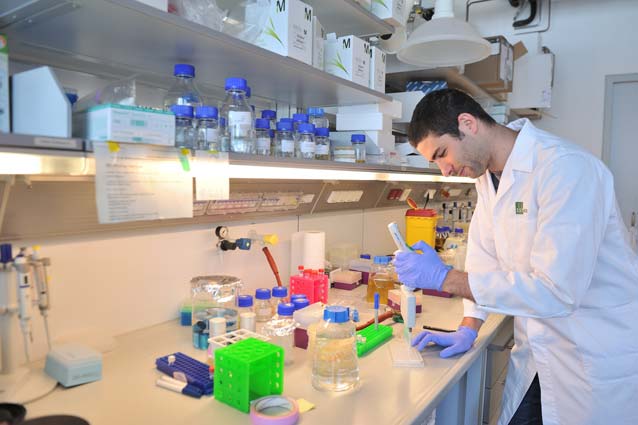June 2, 2017
Predictable genetic interactions
Researchers at IST Austria develop a model to predict how genetic interactions impact gene expression for the first time│ Study published in eLife

Even though we know the sequence of the entire human genome, scientist cannot determine what a particular person will look like. Part of the reason why we cannot read a genome like a book is because the genes, and individual base pairs within genes, interact with each other in many ways. This makes it hard to predict what different genetic combinations will result in. These interactions, also called epistasis, are important for understanding how complex genetic systems function and evolve. A team of researchers at the Institute of Science and Technology Austria (IST Austria), including first authors Mato Lagator and Tiago Paixão, developed a model of epistasis with which they can predict for the first time how two individual base pairs interact. This is the result of a collaboration between the groups of Nick Barton, Jonathan Bollback and Călin Guet at IST Austria, and was published on May 18 in the open access journal eLife.
One important type of interaction between genes is sign epistasis, which, as the name indicates, changes the direction in which a mutation influences a biological trait: from positive to negative or vice versa. This means, for example, that two mutations that are individually harmful can, when found together in the same individual, be beneficial. One example from the world of bacteria are toxins and the exporters that pump them out: on its own, a mutation that produces a toxin can kill a bacterium, while producing only a toxin exporter – but no toxin – wastes precious energy. However, a bacterium that both produces a toxin and a toxin exporter can kill competing organisms, an effect that evolutionary biologists say enhances its fitness.
Epistasis therefore plays a crucial role in the evolution of complex genetic systems, and understanding it is important for answering a wide range of questions, from the evolution of sex to the divergence of species. Predicting whether a specific mutation will be harmful or beneficial is, however, very difficult, and scientists have so far not been able to predict the effect of interactions between different mutations.
In their study, the researchers at IST Austria focused on a very simple model system to predict epistasis. They studied mutations in a bacterial regulatory element, which regulates gene transcription, the process by which a protein is made from a genetic sequence. In the regulatory element that was experimentally studied, gene expression is turned on when the activating RNA polymerase (RNAP) binds, and turned off when a repressive transcription factor (TF) binds. RNAP and TF bind to the same regulatory element, in a manner that is mutually exclusive. The researchers then studied the interactions between mutations in the RNAP and TF binding sites. They found that in their system, the sign of epistasis can switch depending on whether the repressive TF is present or not.
The researchers then went on to build a model with which they could predict the effect of epistasis. They developed a thermodynamic model, which relies on statistical thermodynamic assumptions to model when a gene is expressed. With this model, they can predict the effects of epistasis that they observed in the experimental system. Mato Lagator explains the significance of their work: “Knowing only whether the single mutations are deleterious or beneficial, and the magnitude of this effect, we can predict whether the interaction between two mutations is deleterious or beneficial. Our study shows that it is possible to build a model that accurately predicts epistasis, as long as the molecular mechanisms at play are taken into account.”
Interdisciplinarity – one of the core principles of IST Austria – played an important role in achieving this goal. “The two postdocs who performed the study brought together the knowledge of three fields: Mato Lagator who is both in Jonathan Bollback’s group and in my own has expertise in experimental evolutionary biology and molecular biology, and Tiago Paixao, a postdoc in Nick Barton’s group, brought the knowledge of theoretical aspects to the mix,” explains group leader Călin Guet. “Without combining those different fields the breakthrough would not have been possible,” he adds.
Publication
Mato Lagator, Tiago Paixao, Nick Barton, Jonathan P Bollback, Călin C Guet: On the mechanistic nature of epistasis in a canonical cis-regulatory element. eLife 2017 DOI: dx.doi.org/10.7554/eLife.25192



